In December 2021 then-Gov. Ralph Northam says he will propose eliminating the state's portion of the sales tax on groceries.
Local school divisions in Virginia just learned they will receive $201 million less in state aid than they expected — including $58 million less for the current K-12 school year that is almost three-quarters done.
The Virginia Department of Education has acknowledged the mistake in calculating state basic aid for K-12 school divisions after the General Assembly adopted a two-year budget and Gov. Glenn Youngkin signed it last June. The error failed to reflect a provision to hold localities harmless from the elimination of state’s portion of the sales tax on groceries as part of a tax cut package pushed by Youngkin and his predecessor, Gov. Ralph Northam.
State Superintendent Jillian Balow notified school division superintendents by email on Friday, promising to provide corrected estimates of basic aid for this fiscal year and the next one after the House of Delegates and Senate adopt competing budget revisions on Feb. 9.
People are also reading…
“It was human error on our part,” said Charles Pyle, spokesman for the Department of Education. “We regret that it was not identified until December.”
For big school divisions, the shortfalls are sizable for the two fiscal years — almost $18 million for Fairfax County, the state’s largest; $10.8 million for Chesterfield County; $8.1 million for Henrico County; $3.2 million for Richmond; and $2.6 million for Hanover County.
But the effects could be disproportionately damaging to small and rural school divisions that rely more on state aid for K-12 schools than urban and suburban divisions, which bear a higher share of the cost because of their ability to pay.
“There’s a little bit of panic right now,” said Bristol School Superintendent Keith Perrigan, who also is an officer at the Virginia Association of School Superintendents and president of the Coalition of Small and Rural Schools in Virginia.
Perrigan doesn’t blame the state for the mistake, but he wants to be sure that local school divisions are part of discussions on how to fix the error and help localities with school budgets that were based on the wrong numbers.
“There’s a solution and we’d like to be at the table to come up with that solution, rather than just bemoaning the problem,” he said.
House Appropriations Chairman Barry Knight, R-Virginia Beach, said he was blindsided by the new basic aid numbers on Monday.
“I didn’t know anything about it at all until this afternoon,” Knight said. “I’m not very happy. They did not bother to tell Appropriations that the numbers had changed.”
“We need to have some open communication here,” he said. “Now it’s on me, what do we do?”
Petersburg is an urban member of the coalition because it is small and poor, so it relies more on state aid to pay for schools than bigger divisions do.
Preliminary estimates show that Petersburg would get $853,486 less in state aid, including about $246,000 less for this school year, which is already well into its third quarter.
Bristol, the division that Perrigan leads in the far southwestern corner of the state, would receive $140,488 less in this fiscal year, which ends on June 30, and $347,000 less in the next one, which begins on July 1. It has a low score on the Local Composite Index, which measures a locality’s ability to pay, so it relies more on state funds to meet the Standards of Quality for public education.
“We have already adopted [budgets based on] what we thought we were going to get from the state and localities,” he said. “Now, we are rounding second [base] and headed to third, and finding out that the number is going to be different.”
School divisions also have begun developing their budgets for next school year, while relying on estimates of the state aid they will receive.
Pyle, at the Department of Education, said, “We know that it’s going to be inconvenient.”
He said the mistake, while “regrettable,” did not affect “what the school divisions actually received” from the state during the current year.
“This is not money that school divisions received that they’re going to have to give back,” Pyle said.
Balow, the state superintendent, said the mistake was made when the department inadvertently failed to recognize the effect of a “hold harmless” payment made to local school divisions to offset money they receive directly from the state’s portion of the sales tax on groceries.
The General Assembly included the hold-harmless provision when it eliminated the state portion of the grocery tax, effective Jan. 1. The decision reduced sales tax revenues by $107.3 million in this fiscal year and $265.1 million next year.
As a result, the calculation tool used by the state inflated estimates of basic aid for localities. Balow provided school division superintendents with new formulas to apply to the revised calculation tool released on Dec. 16, the day after Youngkin proposed his new budget.
“We’re not as concerned about the mistake as how do we find a solution to it?” Perrigan said.
29 photos from The Times-Dispatch archives
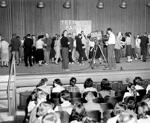
In February 1956, “Teen Age Party,” a televised music and dancing show for the younger crowd, was broadcast on Saturdays from the WRVA Theatre in downtown Richmond.
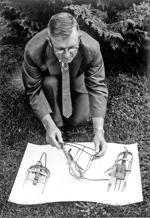
In 1963, Virginia Polytechnic Institute Associate Entomologist J.M. Amos demonstrated a mole trap. Though he said moles weren’t a gardener’s top enemy, their runways were used by other rodents that eat plant roots or bulbs.
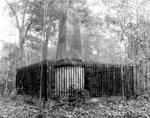
This November 1971 image shows a monument in eastern Henrico County that commemorated the “calamitous year 1771” flood in Richmond. On another side, the monument included an inscription from Ryland Randolph citing 1772 and memorializing his parents.

In August 1953, members of the Monacan Junior Woman’s Club sought volunteers for the upcoming blood drive at Tuckahoe Elementary School in Henrico County. While Mrs. Allan J. Carter called prospects, Mrs. William F. Thornton worked at the typewriter.
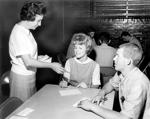
In May 1963, Florence H. Rose outlined registration procedures to students Joan Voss and Harold Costley at the Richmond Youth Employment Center on Ninth Street downtown. By July that year, the center, operated by the Virginia Employment Commission and the Richmond Federation of Parent-Teacher Associations, had helped employ about 9 percent of Richmond’s youth.
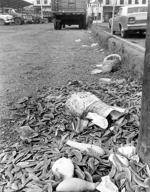
In August 1968, trash was strewn along a street in downtown Richmond. In late June and early July, the eight-day “Fight Litter ’68” campaign gathered a cleanup force of 150 city workers and made progress in seven areas. But the Advertising Club of Richmond planned a follow-up appeal to city residents to join the local fight against litter.
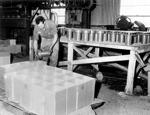
In July 1959, a Tredegar Co. worker collected parts at the company’s new plant on Courthouse Road in Chesterfield County. One of company’s jobs at the time was doing machine work on missile stabilizers.
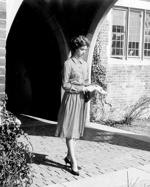
In February 1961, Adrienne Price, a senior at Westhampton College in Richmond, got ready for geography class. She recently had been voted “best dressed” at the school, which is affiliated with the University of Richmond.
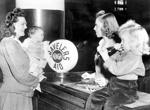
In November 1944, Mrs. Alfred Adkins of Gordo, Ala., and her two young daughters visited the Travelers Aid Society in Richmond en route to Williamsburg, where her military husband was stationed. The society was a charter member of the Richmond War and Community Fund and offered travel assistance to servicemen and civilians.
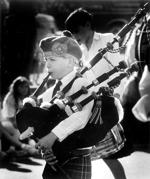
In March 1990, a young bagpiper was part of the St. Patrick’s Day Parade procession on West Broad Street in Richmond.
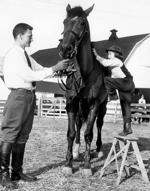
In March 1954, Perry Sinnickson, 8, eagerly mounted a horse with little assistance from instructor Stewart Felvey. They were at the Deep Run Pony Club in Goochland County, a new equestrian program for juniors and the first club of its kind in Virginia.
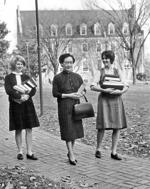
In November 1964, St. Catherine’s School students Cindy McDonough (left) and Rozzie Kemper (right) accompanied teacher Lucile Tang Liu to class. Liu, the new Upper School librarian and a French and Chinese history teacher, was from China and moved to Richmond from Montreal as one of several international teachers added to the school faculty.

In June 1966, 8-year-old summer day camper Larry Harris surveyed the water facilities at Camp Thunderbird, which the YMCA opened that year in Chesterfield County. For more than 50 years before, the Boy Scouts had operated Camp Shawondasee there.

In December 1947, T.E. Burton Jr. diagnosed a patient at his doll hospital on Forest Hill Avenue in Richmond. Burton, a state Highway Department employee, was part-time chief surgeon at the doll hospital he ran out of his home. He got into the repair business when his two young daughters received as gifts antique china dolls that were badly in need of work. Burton averaged about 10 patients a week, with a busy season around the holidays.

In October 1982, Tim Smith checked the progress of a bunch of bananas in Highland Springs. His father, George, began cultivating the banana grove 10 years earlier after a friend gave him a plant as a gift. The plant grew and multiplied into 89 banana trees, ranging from 6-inch shoots to 18-foot trees. (George Smith said he didn’t eat the fruit — he grew them because he said they were beautiful plants.)
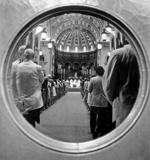
In June 1973, the pews were full at Cathedral of the Sacred Heart in Richmond for a service marking the 50th anniversary of the ordination of the Most Rev. John J. Russell, retired bishop of the Catholic Diocese of Richmond.
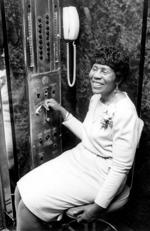
In April 1985, Blanche Whitaker operated the elevator one last time at Central Fidelity Bank in downtown Richmond. Whitaker was retiring after more than three decades and was believed to be the last manual elevator operator in the city. With her departure, the bank planned to convert the elevator to automatic control.

In December 1991, the Westover Hills Neighborhood Association held a dedication ceremony for the recently erected bronze markers in the median on Westover Hills Boulevard in South Richmond.
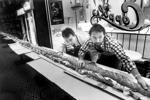
In August 1989, Coppola’s Deli owner Joe Coppola (right) and manager Bill Gerloff carefully assembled a 40-foot Italian hero in the Carytown eatery. The giant sub required three cases of tomatoes, 50 pounds of cold cuts and 15 pounds of provolone cheese. The sandwich was made for the Carytown Watermelon Festival, where patrons could buy 5 inches for $5.
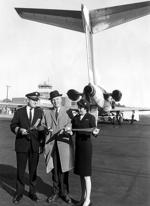
In November 1965, Richmond Mayor Morrill M. Crowe cut a ceremonial ribbon to mark the inauguration of the Eastern Airlines passenger service from Byrd Field to New York. The pilot for the flight, Capt. R.D. Tyler, and stewardess Margaret McLaughlin held the ribbon.
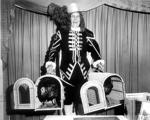
In November 1961, state Sen. John J. Wicker dressed as a colonist and, having flown to Boston, presented the governor of Massachusetts with documents — and live turkeys — to make the case that Virginia held the first Thanksgiving in 1619, two years before the Pilgrims held a celebration at Plymouth.
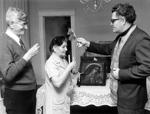
In January 1972, the Rev. Constantine N. Dombalis, leader of Saints Constantine and Helen Greek Orthodox Church in Richmond, sprinkled holy water on the foreheads of two parishioners at the beginning of his tour to perform blessings of the homes for his 300 parishioners.
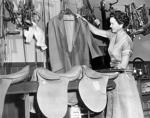
In July 1954, Mrs. Arthur Franklin worked on a display at Jeter’s, her harness shop at 221 E. Main St. in Richmond. The shop was founded in 1888 and had been a supplier of saddles and bridles for Abercrombie & Fitch, the New York sporting goods house. By the 1950s, a key customer was Colonial Williamsburg: It equipped its horses with harnesses and other accessories made by Jeter’s in strict accordance with 18th-century design.

In September 1975, handler Bobby Barlow showed off his basset hound, Champion Slippery Hill Hudson, who was named best in show at the Virginia Kennel Club dog show at the Arena in Richmond. At left is judge George C. Ehmig, and at right is show executive Lawrence W. Bracken Jr.

In October 1959, the rain-swollen Rivanna River flooded the Albemarle County Fairgrounds, postponing the opening of a carnival. A pelican that was part of a wildlife exhibit for the event stayed dry while tents and vehicles were under several feet of water.
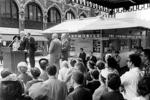
In the 1960s, the Artmobile for the Virginia Museum of Fine Arts was essentially a rolling exhibit. The updated version, a museum and classroom on wheels, is expected to stop at schools, retirement facilities and community centers.
"local" - Google News
January 31, 2023 at 08:00AM
https://ift.tt/HvByZWC
Local school divisions short $201 million in aid because of state error - Richmond Times-Dispatch
"local" - Google News
https://ift.tt/yok5cRQ
https://ift.tt/CxaSuBz
Bagikan Berita Ini














0 Response to "Local school divisions short $201 million in aid because of state error - Richmond Times-Dispatch"
Post a Comment